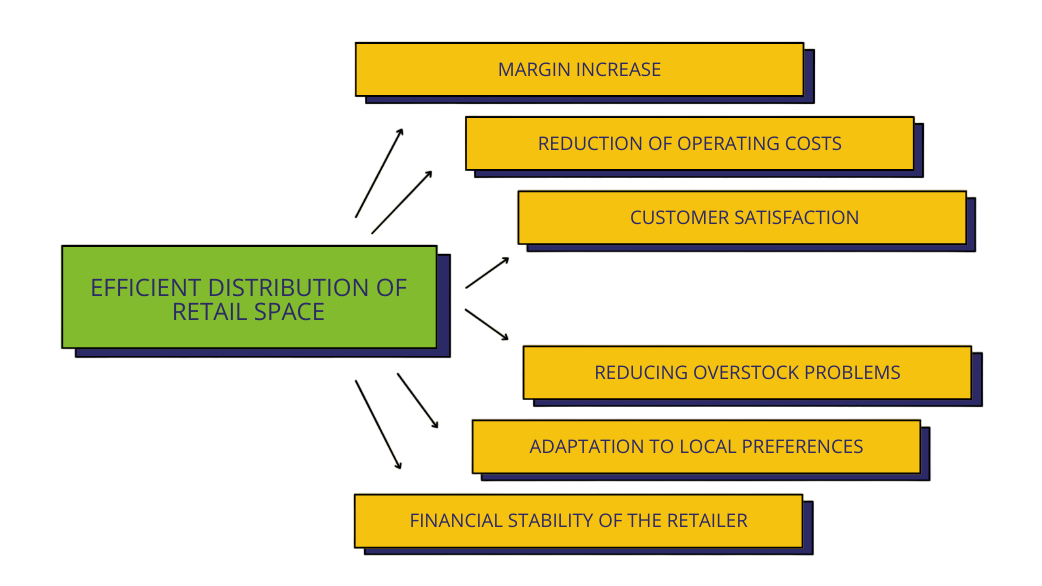
Allocation of retail space among subcategories and brands
In today’s retail environment, where competition grows fiercer each year, effective management of retail space has become a key factor for success. Shelf space is one of the most valuable resources for retailers, and its allocation directly impacts key business metrics such as sales volume, profitability, and customer satisfaction.
However, despite the importance of this task, retailers often make mistakes when allocating shelf space. For example, placing too much emphasis on sales in monetary terms or evenly distributing space among all brands can lead to decreased profitability. These approaches hinder the main goal of merchandising—maximizing margins through efficient assortment management and product placement.
In this article, we will discuss how to properly allocate retail space between subcategories and brands. We will cover:
The recommendations provided are suitable for both large chains and local stores seeking to effectively manage their resources and boost profitability. Using data and practical examples, you will be able to turn your shelves into a growth engine for your business.
However, despite the importance of this task, retailers often make mistakes when allocating shelf space. For example, placing too much emphasis on sales in monetary terms or evenly distributing space among all brands can lead to decreased profitability. These approaches hinder the main goal of merchandising—maximizing margins through efficient assortment management and product placement.
In this article, we will discuss how to properly allocate retail space between subcategories and brands. We will cover:
- Mistakes in approach and their consequences for the business.
- Principles of space allocation between categories and within categories.
- How optimizing shelf space can help increase profitability, reduce costs, and improve customer satisfaction.
The recommendations provided are suitable for both large chains and local stores seeking to effectively manage their resources and boost profitability. Using data and practical examples, you will be able to turn your shelves into a growth engine for your business.
Mistaken approaches to retail space allocation
When allocating shelf space, retailers often make mistakes that can negatively impact profitability and the efficient use of retail areas. Let’s look at the most common approaches that no longer work in today’s market.
This is one of the most common methods used in merchandising. At first glance, it seems logical: if a category generates the highest revenue, it should receive more shelf space. However, this approach overlooks a crucial factor—profitability.
Allocating space based on sales revenue
Why is this approach flawed?
Case example
Categories with high revenue, such as traffic-driving essentials (e.g., bread, sugar, milk), often have low profit margins. Allocating excessive space to these products limits opportunities for displaying higher-margin items that could generate additional income for the retailer.
A supermarket chain allocated 30% of shelf space to essential goods like bottled water and sugar due to their high turnover. However, analysis revealed that these products contributed only 5% of total profit margin. As a result, more profitable categories, such as delicacies and premium beverages, were squeezed into smaller areas, reducing their sales potential.
Another common mistake is allocating shelf space without considering the type and capacity of the equipment. Refrigerators, shelves, hanging racks, and freezers have different storage capacities, and distributing space equally among them often leads to inefficient use of retail space.
Ignoring differences in equipment types
Why is this wrong?
Solution
For example, a 50 cm deep shelf holds more products than a narrow refrigerator, yet these differences are often ignored when calculating linear shelf space. This creates a mismatch between actual capacity and category needs.
Consider the storage capacity of each type of equipment and allocate space based on shelf area, not just length.
In some cases, retailers allocate shelf space evenly across all brands and categories. While this approach may seem fair, in reality, it creates several issues.
Equal distribution approach
Why is this approach flawed?
Real-world example
Low-demand or low-margin products take up valuable shelf space that could be used more effectively.
Overstock issues arise, as slow-moving items accumulate on shelves, tying up the retailer’s working capital.
Overstock issues arise, as slow-moving items accumulate on shelves, tying up the retailer’s working capital.
A store allocated equal shelf space to all juice brands, regardless of their sales performance. As a result, best-selling brands sold out quickly, causing stock shortages, while less popular brands occupied shelves without generating profit.
Mistaken approaches prevent retailers from achieving the main goal of merchandising—maximizing profitability. They limit opportunities for higher-margin categories and lead to unnecessary costs in assortment management.
To avoid these issues, retailers must implement data-driven methods based on sales performance and profit margins.
To avoid these issues, retailers must implement data-driven methods based on sales performance and profit margins.
How to properly allocate space between categories
Allocating retail space is a strategic task that requires in-depth analysis and consideration of various factors. Unlike flawed approaches, effective space allocation is based on data regarding category profitability, consumer demand, and equipment characteristics. Here are the key principles that will help you manage shelf space effectively.
The main factor in shelf space allocation should be category profitability. Categories that generate the highest profit margins should receive not only more space but also prime locations, such as golden shelves, aisle end caps, and high-traffic areas.
Proportional to margin contribution
Why is this important?
The higher the category’s margin, the more revenue the retailer earns per square meter allocated to it. It’s crucial to consider not just sales volume, but also the actual profit contribution of each category.
The higher the category’s margin, the more revenue the retailer earns per square meter allocated to it. It’s crucial to consider not just sales volume, but also the actual profit contribution of each category.

Solution
Use analytical data to determine each category’s share of the store’s total profit margin. This will provide an objective basis for deciding which categories deserve more space.
Use analytical data to determine each category’s share of the store’s total profit margin. This will provide an objective basis for deciding which categories deserve more space.

For precise allocation, it’s important to consider not only shelf length (linear meters) but also the actual area of the shelves. Shelves vary in depth, which affects their storage capacity. Categories with a large number of small products (e.g., grocery) require more space than categories with larger packaging.
Accounting for shelf space area
Example
In one hypermarket chain, switching from calculating space by linear meters to accounting for shelf space area increased the capacity of the grocery department by 15%, resulting in an 8% increase in category sales.
In one hypermarket chain, switching from calculating space by linear meters to accounting for shelf space area increased the capacity of the grocery department by 15%, resulting in an 8% increase in category sales.

Each type of equipment has specific features that must be considered when allocating space:
- Refrigerators – designated for perishable and chilled products.
- Shelving units – suitable for medium and large packaged goods.
- Freezers – used for frozen products, where clear visibility is essential.
Segmentation by equipment type
Tip
Segment equipment by category. For example, refrigerators can be divided into separate zones for beverages, dairy products, and frozen desserts to enhance organization and accessibility.
Segment equipment by category. For example, refrigerators can be divided into separate zones for beverages, dairy products, and frozen desserts to enhance organization and accessibility.

Space allocation should reflect local demand patterns, especially for retail chains operating in different regions.
Category localization based on consumer demand
Example
In urban stores with a younger, more active customer base, more space is allocated to ready-to-eat and healthy food options.
In rural stores, the focus shifts to staple products like grocery essentials and basic necessities, aligning with local consumer needs.
In urban stores with a younger, more active customer base, more space is allocated to ready-to-eat and healthy food options.
In rural stores, the focus shifts to staple products like grocery essentials and basic necessities, aligning with local consumer needs.

Category and subcategory placement should align with the logic of the customer journey. For example:
- Perishable goods are placed closer to the exit to minimize time outside refrigeration.
- Essential items (e.g., bread, milk) are located deeper in the store, encouraging shoppers to walk past other categories, increasing exposure to additional products.
Optimization for an improved customer journey
Case example
A supermarket chain analyzed profitability and sales by category. After redistributing shelf space based on data, high-margin categories (e.g., premium cheeses, delicacies) were given prime locations, while low-margin products (e.g., canned goods, grains) were moved to less prominent areas. As a result, total margin increased by 10% over six months.
A supermarket chain analyzed profitability and sales by category. After redistributing shelf space based on data, high-margin categories (e.g., premium cheeses, delicacies) were given prime locations, while low-margin products (e.g., canned goods, grains) were moved to less prominent areas. As a result, total margin increased by 10% over six months.

Space allocation within categories
Once the space for a category is determined, the next step is to distribute it among subcategories, brands, and SKUs. This process must balance commercial factors with shopper convenience.
A well-structured in-category layout enhances profitability while reducing operational costs associated with shelf management.
A well-structured in-category layout enhances profitability while reducing operational costs associated with shelf management.
The golden rule for space distribution within a category is to consider sales volume in units. Products that sell more frequently should have a higher number of facings on the shelf.
- Best-selling products ensure steady stock rotation, reducing replenishment costs.
- This prevents situations where high-demand items sell out too quickly, leaving empty shelves.
Proportionate to sales in units

Slow-moving products should take up less space to avoid tying up the retailer's working capital.
Striking a balance between product availability and actual sales performance is essential.
Regularly analyze sales data and adjust facings for slow-moving items accordingly.
Striking a balance between product availability and actual sales performance is essential.
Regularly analyze sales data and adjust facings for slow-moving items accordingly.
Optimization to prevent overstock

Even within the same category, some products have higher margins than others. These items should receive prime shelf positions, such as central facings at eye level, to maximize profitability.
Prioritizing high-margin products

Not all categories require the same space allocation approach:
- In FMCG categories (e.g., beverages, groceries), the number of facings should be proportional to unit sales.
- In jewelry or consumer electronics, each SKU is given a fixed display space to ensure product visibility.
Considering product-specific needs

Shelf space allocation should also factor in restocking efficiency.
If high-demand items have too few facings, staff must refill shelves frequently, increasing labor costs.
Provide best-selling products with enough facings to minimize restocking efforts and improve operational efficiency.
If high-demand items have too few facings, staff must refill shelves frequently, increasing labor costs.
Provide best-selling products with enough facings to minimize restocking efforts and improve operational efficiency.
Logistics within the category

The impact of proper space allocation on business

Effective space allocation not only increases margin but also positively impacts key aspects of retail operations: processes, financial performance, and customer experience. Let’s explore how the right category and product placement strategy can bring real business benefits.
✔️ Margin growth
Allocating space based on profitability directs customer attention to higher-margin categories and products. This leads to increased revenue without requiring a significant boost in sales volume.
✔️ Reduction of operational costs
Smart SKU space allocation helps reduce shelf restocking costs. Increasing facings for high-demand products decreases restocking frequency, saving time and labor costs.
Use sales data to optimize facings for products with varying turnover rates.
✔️ Enhanced customer satisfaction
When products are arranged logically and conveniently, it improves the overall shopping experience. Customers find items faster, which increases the average basket size and fosters brand loyalty.
✔️ Minimizing overstock issues
Proper space distribution prevents slow-moving products from accumulating, reducing inventory management costs and frozen capital.
Regularly analyze sales data and adjust planograms to make room for more in-demand products.
✔️ Adaptation to local preferences
Considering regional demand variations allows retailers to better cater to customer needs and make the most of available space.
✔️ Financial stability for retailers
Optimized space management helps retailers use their resources more efficiently, leading to:
Strategic space allocation across categories, subcategories, and brands enables retailers to boost margins while gaining a competitive advantage. This improves financial stability and strengthens market positioning.
✔️ Margin growth
Allocating space based on profitability directs customer attention to higher-margin categories and products. This leads to increased revenue without requiring a significant boost in sales volume.
✔️ Reduction of operational costs
Smart SKU space allocation helps reduce shelf restocking costs. Increasing facings for high-demand products decreases restocking frequency, saving time and labor costs.
Use sales data to optimize facings for products with varying turnover rates.
✔️ Enhanced customer satisfaction
When products are arranged logically and conveniently, it improves the overall shopping experience. Customers find items faster, which increases the average basket size and fosters brand loyalty.
✔️ Minimizing overstock issues
Proper space distribution prevents slow-moving products from accumulating, reducing inventory management costs and frozen capital.
Regularly analyze sales data and adjust planograms to make room for more in-demand products.
✔️ Adaptation to local preferences
Considering regional demand variations allows retailers to better cater to customer needs and make the most of available space.
✔️ Financial stability for retailers
Optimized space management helps retailers use their resources more efficiently, leading to:
- Lower restocking costs
- Faster inventory turnover
- Increased profitability through high-margin product sales
Strategic space allocation across categories, subcategories, and brands enables retailers to boost margins while gaining a competitive advantage. This improves financial stability and strengthens market positioning.
The allocation of retail space is not just a matter of shelf organization but a strategic process that directly impacts a retailer’s profitability. We have discussed the key mistakes that hinder the effective use of shelf space and proposed approaches based on analytics, margin optimization, and customer needs. Now, let’s summarize and highlight practical steps that will help retailers achieve success.
Conclusion and practical tips
- Shelf space as an asset – It is one of the retailer’s most valuable resources and should be utilized as efficiently as possible, considering category and product margins.
- Avoid common mistakes – Allocating space based on revenue alone, ignoring equipment differences, or distributing shelf space equally leads to profit loss and reduced operational efficiency.
- Margin-based prioritization – Categories and products with higher profitability should be given the best placements (golden shelves, aisle ends) and more space to maximize overall margin.
- Dynamic optimization – Regular sales data analysis, planogram adjustments, and consideration of local preferences allow retailers to remain flexible and adapt to market changes.
Key takeaways
Leverage analytics
Optimize shelf space
Prioritize the customer experience
Implement technology
Test and adapt
Merchandising is the art of designing a retail space that maximizes both profitability and customer satisfaction. Effective shelf space distribution enhances margin, streamlines operations, cuts costs, and creates a seamless shopping experience.
- Calculate the contribution of each category and subcategory to overall margin to allocate shelf space objectively.
- Use unit sales data to distribute facings among SKUs effectively.
Optimize shelf space
- Shift from linear meter calculations to shelf space area metrics for more accurate allocation.
- Identify the best shelf positions for each category to enhance visibility and sales potential.
Prioritize the customer experience
- Arrange products logically and conveniently to improve navigation and reduce search time.
- Use high-margin categories to create a memorable and engaging shopping experience.
Implement technology
- Automate planogram planning and management to speed up updates and reduce errors.
- Use AI tools to analyze sales data and predict demand trends.
Test and adapt
- Run pilot projects before rolling out major changes in shelf layout.
- Continuously monitor and adjust space allocation based on performance metrics.
Merchandising is the art of designing a retail space that maximizes both profitability and customer satisfaction. Effective shelf space distribution enhances margin, streamlines operations, cuts costs, and creates a seamless shopping experience.
Practical tips for retailers
Tilda Publishing